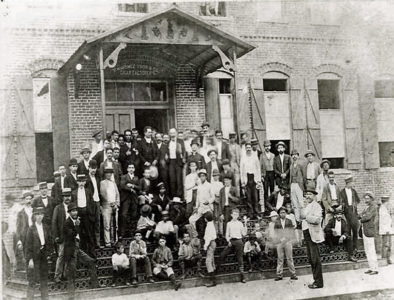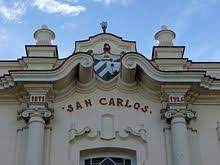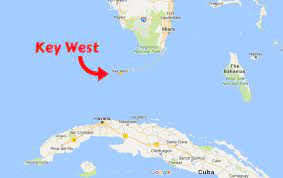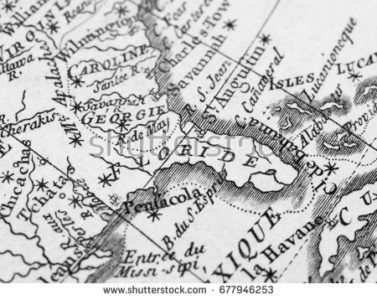A SOLO 94 MILLAS DEL TERRITORIO DE CUBA. CAYO HUESO (KEY WEST) EN LA HISTORIA CUBANA. FOTOS.
Key West es una isla en el Estrecho de Florida, dentro del estado estadounidense de Florida. A solo 94 millas del territorio de Cuba.
Junto con todas o partes de las islas separadas de Dredgers Key, Fleming Key, Sunset Key y la parte norte de Stock Island, constituye la ciudad de Key West.
La isla de Cayo Hueso tiene aproximadamente 4 millas (6 kilómetros) de largo y 1 milla (2 km) de ancho, con una superficie total de 4,2 millas cuadradas (11 km2). Se encuentra en el extremo más al sur de la Ruta 1 de los EE. UU., La carretera norte-sur más larga de los Estados Unidos.
Key West está a unas 94 millas (153 km) al norte de Cuba en sus puntos más cercanos. También se encuentra a 130 millas (210 km) al suroeste de Miami por aire, a unas 165 millas (266 km) por carretera y a 106 millas (171 km) al noreste de La Habana.
CAYO HUESO Y CUBA
Cayo Hueso es el nombre original en español de la isla de Cayo Hueso o Cayo Hueso, el punto más cercano de Estados Unidos a Cuba. Los hispanohablantes de hoy también usan el término Cayo Hueso para referirse a esta isla. Se dice que la isla estaba llena de restos (huesos) y que la isla era el cayo occidental con un suministro de agua seguro.
En la época precolombina, Key West fue habitado por la gente de Calusa. El primer europeo en visitar fue Juan Ponce de León en 1521 cuando Florida se convirtió en territorio español, luego un pueblo pesquero y de rescate con una pequeña guarnición que se instaló aquí. En 1815 el gobernador español de Cuba en La Habana transfirió la isla de Cayo Hueso a Juan Pablo Salas, oficial de la Real Artillería Armada Española, con base en San Agustín, Florida. Salas estaba tan ansioso por vender la isla que la vendió dos veces.
Al parecer, Cayo Hueso era considerado parte legal de Florida ya que cuando España cedió la península a Inglaterra, para poner fin a la ocupación de La Habana por parte de los ingleses, Cayo Hueso se consideró cedido, siendo trasladados los residentes del pueblo de Cayo Hueso a La Habana.
Inglaterra no prestó mucha atención a Cayo Hueso y pronto el Cayo comenzó a ser utilizado por pescadores cubanos y bahameños. Tan pronto como Estados Unidos logró su independencia, algunas personas de la nueva nación comenzaron a llegar al Cayo. Durante estos años ningún gobierno ejerció control o reconocimiento sobre Key West.
Por orden del 7 de febrero de 1822, el 25 de marzo de 1822, el teniente Matthew C. Perry de la Marina de los Estados Unidos llegó a Key West en el Shark y plantó la bandera estadounidense reclamando la llave como propiedad de los Estados Unidos. Perry procedió a cambiar el nombre a “Isla de Thompson” en honor al Secretario de la Marina Smith Thompson y nombró al puerto “Port Rodgers” en honor a John Rodgers, un héroe de la guerra de 1812. Ninguno de los nombres permaneció, sin embargo, Key West ha sido propiedad de los Estados Unidos hasta el presente.
CAYO HUESO A FINALES DEL 1800
En 1890, Key West tenía una población de aproximadamente 18.800 habitantes y era la ciudad más grande y rica de Florida. La mitad de los residentes dijeron ser de origen cubano, y Key West tenía alcaldes cubanos regularmente, incluido el hijo de Carlos Manuel de Céspedes, el padre de la República de Cuba, quien fue elegido alcalde en 1876.
Los cubanos han participado activamente en el desarrollo de 200 fábricas en la ciudad, una producción de 100 millones de puros al año. José Martí realizó varias visitas para buscar reclutas para la independencia de Cuba a partir de 1891 y fundó el Partido Revolucionario Cubano en sus visitas a Cayo Hueso y el ‘Club San Carlos’ fundado por cubanos residentes en el lugar.
Club San Carlos es uno de los lugares más bellos e históricos de Florida. Fue fundado en 1871 por exiliados cubanos de Key West como un centro educativo, cívico y patriótico. El Club es de usos múltiples que sirve como museo, biblioteca, galería de arte, teatro y escuela. Ubicada en el corazón del distrito histórico de Cayo Hueso, San Carlos es considerada la cuna del movimiento independentista cubano.
Fue en San Carlos donde José Martí se unió a la comunidad del exilio en 1892 para lanzar la fase final de su campaña por la independencia cubana. A Martí le gustaba tanto San Carlos que lo llamó “La Casa Cuba”.
El bellamente restaurado Instituto San Carlos abrió sus puertas el 4 de enero de 1992, exactamente cien años después del día en que José Martí pronunció su primer discurso en el Instituto. Más de 5,000 personas asistieron a la celebración de reapertura de tres días. La calle Duval se cerró para la ocasión y una orquesta sinfónica frente a San Carlos interpretó la música de los grandes compositores cubanos.
El 15 de noviembre de 2021 se encendieron las luces del Club San Carlos “La Casa Cuba” y la antorcha de la libertad de los cubanos para recibir el grito de Independencia que nos legó José Martí y que seguimos esperando ansiosos.
AT ONLY 94 MILES OF CUBA’S TERRITORY. CAYO HUESO (KEY WEST) IN THE CUBAN HISTORY. PHOTOS
Key West is an island in the Straits of Florida, within the U.S. state of Florida. At only 93 miles from Cuba territory.
Together with all or parts of the separate islands of Dredgers Key, Fleming Key, Sunset Key, and the northern part of Stock Island, it constitutes the City of Key West.
The Island of Key West is about 4 miles (6 kilometers) long and 1 mile (2 km) wide, with a total land area of 4.2 square miles (11 km2).[5] It lies at the southernmost end of U.S. Route 1, the longest north-south road in the United States.
Key West is about 94 miles (153 km) north of Cuba at their closest points. It is also 130 miles (210 km) southwest of Miami by air, about 165 miles (266 km) by road, and 106 miles (171 km) north-northeast of Havana.
CAYO HUESO AND CUBA
Cayo Hueso is the original name in Spanish for the island of Cayo Hueso or Key West, the closest point in the United States to Cuba. Spanish speakers today also use the term Cayo Hueso when referring to this island. It is said that the island was full of remains (bones) and that the island was the western key with a safe supply of water.
In pre-Columbian times, Key West was inhabited by the Calusa people. The first European to visit was Juan Ponce de León in 1521 when Florida became a Spanish territory, then a fishing and rescue town with a small garrison that settled here.
In 1815 the Spanish governor of Cuba in Havana transferred the island of Key West to Juan Pablo Salas, an officer of the Royal Spanish Armed Artillery, based in Saint Augustine, Florida. Salas was so eager to sell the island that he sold it twice.
Apparently, Key West was considered a legal part of Florida since when Spain ceded the peninsula to England, to end the occupation of Havana by the English, Key West was considered ceded, with the residents of the town in the Key being transferred to Havana.
England did not pay much attention to Key West and soon the Key began to be used by Cuban and Bahamian fishermen. As soon as the United States achieved its independence, some people from the new nation began to come to the Key. During these years no government exercised control or recognition over Key West.
By order of February 7, 1822, on March 25, 1822, Lieutenant Matthew C. Perry of the US Navy arrived in Key West on the Shark and planted the American flag claiming the key as the property of the United States. Perry proceeded to change the name to “Thompson’s Island” in honor of Secretary of the Navy Smith Thompson and named the port “Port Rodgers” in honor of John Rodgers, a hero of the war of 1812. Neither name remained, without However, Key West has remained the property of the United States to the present.
CAYO HUESO AT THE LATE 1800s
In 1890, Key West had a population of about 18,800 and was the largest and richest city in Florida. Half of the residents said they were of Cuban origin, and Key West regularly had Cuban mayors, including the son of Carlos Manuel de Céspedes, the father of the Republic of Cuba, who was elected mayor in 1876.
Cubans have actively participated in the development of 200 factories in the city, a production of 100 million cigars annually. José Martí made several visits to look for recruits for the independence of Cuba from 1891 and founded the Cuban Revolutionary Party in his visits to Key West and the ‘Club San Carlos’ founded by Cubans residing in the place.
Club San Carlos is one of the most beautiful and historic places in Florida. It was founded in 1871 by Cuban exiles from Key West as an educational, civic, and patriotic center. The Club is a multipurpose one that serves as a museum, library, art gallery, theater, and school. Located in the heart of the historic district of Key West, San Carlos is considered the cradle of the Cuban independence movement.
It was in San Carlos where José Martí joined the exile community in 1892 to launch the final phase of his campaign for Cuban independence. Martí liked San Carlos so much that he called it “La Casa Cuba.”
The beautifully restored San Carlos Institute opened its doors on January 4, 1992, exactly one hundred years after the day José Martí gave his first speech at the Institute. More than 5,000 people attended the three-day reopening celebration. Duval Street was closed for the occasion and a symphony orchestra in front of San Carlos played the music of the great Cuban composers.
On November 15, 2021, the lights of Club San Carlos “La Casa Cuba” and the torch of freedom for Cubans were lit to receive the cry of Independence that Jose Marti bequeathed to us and that we are still anxiously waiting for.
Agencies/ Wiki/ Key WestHist./ Extractos/ Excerpts/ Internet Photos/ Arnoldo Varona/ www.TheCubanHistory.com
THE CUBAN HISTORY, HOLLYWOOD.



 A SOLO 94 MILLAS DE CUBA: Cayo Hueso (Key West) en la Historia Cubana. PHOTOS. * AT ONLY 94 MILES FROM CUBA. Key West (Cayo Hueso) in the Cuban History. PHOTOS.
A SOLO 94 MILLAS DE CUBA: Cayo Hueso (Key West) en la Historia Cubana. PHOTOS. * AT ONLY 94 MILES FROM CUBA. Key West (Cayo Hueso) in the Cuban History. PHOTOS.








